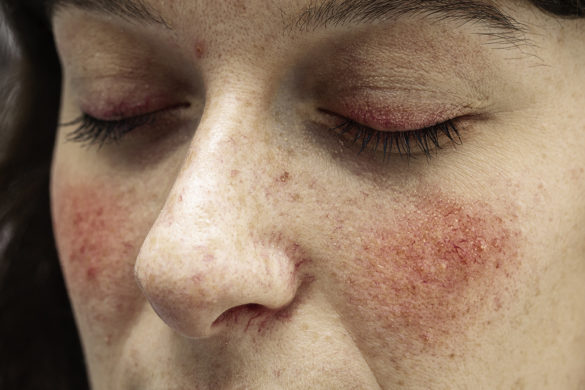Facial redness and flushing have a number of causes from diet to hormonal imbalances. Rosacea is a ‘red’ rash that usually occurs on the face. It is a long-term condition which generally affects Caucasian middle-aged people, women being more commonly affected than men. It can, however, affect all skin types and all age ranges, including rare occurrences in children.
 The cheeks and nose are most commonly involved, followed by the forehead. More rarely, the scalp, upper chest, upper back and even limbs can be involved. The affected skin shows redness, broken blood vessels, red spots and pus-filled spots. The redness or flushing comes and goes. The eyes and eyelids are not uncommonly involved with swelling and reported ‘grittiness’.
The cheeks and nose are most commonly involved, followed by the forehead. More rarely, the scalp, upper chest, upper back and even limbs can be involved. The affected skin shows redness, broken blood vessels, red spots and pus-filled spots. The redness or flushing comes and goes. The eyes and eyelids are not uncommonly involved with swelling and reported ‘grittiness’.
The precise cause remains unestablished, but more is known about the mechanism. This involves widening of blood vessels, inflammation and swelling of the skin, giving it a thickened appearance, which can be permanent (the skin is then said to be phymatous). Some theories suggest a role for skin or gut bacteria, but this is as yet unproven. Nonetheless, certain antibiotics have been shown to be clinically effective.
There are many reports of triggers such as heat, alcohol, stress, certain drugs, spicy foods and exercise but equally, some patients report no triggers at all.
Rosacea is usually worsened by natural sunlight but, less commonly, can also be improved by it.
There are a number of conditions that mimic rosacea, and acne vulgaris is probably the commonest source of confusion. Other possibilities include lupus erythematosus, perioral dermatitis, seborrhoeic dermatitis and nasal sarcoidosis.
The age range and a number of clinical clues enable a dermatologist to confirm rosacea and exclude other conditions. A good history and careful examination are often sufficient with no blood tests needed to confirm or refute rosacea.
There is no proven cure for rosacea. There are, however, long term treatments which are safe and effective.
Several antibiotics in cream, lotion, gel or tablet form are effective for the inflammation (bumps and pus spots) of rosacea but, they work less well for the flushing and broken vessels. On the other hand, laser treatments work better for the flushing and vessels than for the inflammation. It is best to visit a dermatologist who can advise you on the best possible course of treatment.
What can I do?
- Avoid excessive washing and rubbing of facial skin as this can exacerbate rosacea.
- Keep an eye out for anything you think triggers the rosacea. Avoidance of trigger factors will often produce considerable improvement.
- Most treatments for acne don’t work for rosacea and some may be irritant. Avoid using somebody else’s acne treatments.
- Avoid using any creams with steroids – they will generally worsen rosacea.
- Have you noticed flushing with any of your medications? If so, your doctor may be able to use an alternative medication.


